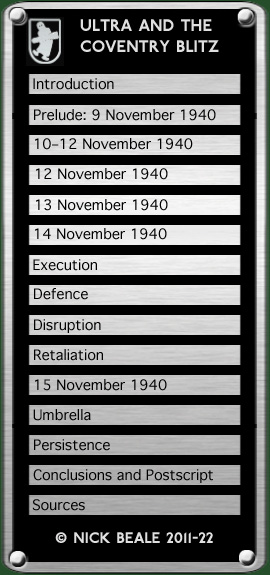|
In the first week of November, Addison dispatched three trial flights to establish whether sufficient accuracy could be achieved flying down the German beam and releasing bombs at the point where the signal cut out in the “silent zone” over the antenna arrays. The conclusion was that “fairly accurate bombing should be possible” and live missions by WIDU’s two Whitleys were planned for the second week of the month. After one more encouraging trial, the first live operation was flown on the night of 12/13 November by S/L Bufton and F/O Bull but was unsuccessful owing to a strong cross wind. The second attack followed on 14/15 November. Addison ordered WIDU’s aircraft to be bombed-up and at readiness in Boscombe Down, Wiltshire from 17.00 BST on 14 November. On the 100-mile outward flight, they were to climb to operational height between base and the South Coast, then make straight to the target area. The first Whitley would go in at 10,500 ft., the second 1,000 ft. higher and 15 minutes later. Each would carry 4 x 500 lb. and 5 x 250 lb. general purpose bombs (although six of the latter were originally proposed). Both aircraft were to return via Bridport in Dorset (where a 1./KGr. 100 Heinkel had come down eight days earlier) crossing the coast at 7,000 ft. before descending to 2,500 ft. between there and Boscombe. In the attack, one stick of bombs, apparently from the second Whitley, was observed to straddle Knickebein IV, which fell silent for the rest of the night, as did the “river” transmitters. The pilot of the second aircraft came under “very considerable fire indeed” from the Flak defences and in the moonlight was able to see parallel lines of balloons at 5–6,000 ft. about 1½–2 miles east of Cap de la Hague. It was thought that these barrages had been placed to defend the transmitters as far as possible while ensuring that their cables did not interfere with the beams. Leutnant Langhelm reported a deliberate attack on SPREE with 10 bombs dropped in a line running eastwards. Despite the last salvo falling 300 m. from the Kontrollwagen (a van with an antenna for checking the beam’s alignment) there had been no damage to personnel or materiel. From Cherbourg Obltn. Mayer reported that a second attack had developed at about 20.00 GMT: three bombs had struck the hutments at WOTAN 2, killing three men and wounding several severely and many slightly. From this he concluded that the first attack on SPREE (meaning that on 10/11 October?) appeared in fact to have been intentional and requested 50,000 sand-bags immediately, along with the assignment of an Arbeitsdienst (Labour Service) company for three weeks to carry out protective and camouflage work for WESER and SPREE. No. 80 Wing reported that an intercepted instruction to the VHF Beam Station in Cherbourg to switch to a new target had brought the reply that the apparatus was unserviceable. This was taken as evidence of the Whitleys’ success but when transmissions resumed the following night the British surmised that after being bombed twice in 15 minutes, the Germans had switched off, thinking that more aircraft might be on their way.
Addison went on to say that all radio counter-measures had been implemented, including interference with enemy radio beacons and navigational beams but: While these operations were technically successful they are unlikely to have contributed materially to the defence, since the night was so clear and bright that radio navigational aids were not essential.
continued on next page …
|
||||

